 What is a cross connection? It's an actual or potential connection between a potable water line and any waste pipe, soil pipe, sewer, drain or other unapproved source. These connections pose a threat to public health by allowing contaminants to be siphoned or forced into the public drinking water system under certain hydraulic conditions.
What is a cross connection? It's an actual or potential connection between a potable water line and any waste pipe, soil pipe, sewer, drain or other unapproved source. These connections pose a threat to public health by allowing contaminants to be siphoned or forced into the public drinking water system under certain hydraulic conditions.
In a residential setting, cross connections include submerged hoses, lawn irrigation systems, chemical spray applicators, connections to private wells, boilers, solar heating systems and fire sprinkler systems. These connections, if left unprotected, could introduce contaminants to the water system. Consumers play an important role in protecting public health by notifying the Water Department of any cross connections and helping to eliminate or properly protect the connection by installing a backflow prevention device.
There are six types of backflow prevention devices that are available to protect the water system from cross connections. The proper device is selected based on the degree of hazard of the connection.
Air Gap - The air gap is the most effective device available. It simply separates the public water system from the cross connection by at least 1 inch or twice the pipe diameter, which ever is greater. Air gaps are commonly found on connections made to drain or sewer lines.
Reduced Pressure Principle Backflow Preventer (RP) - The RP is used for high hazard connections where an air gap is not feasible. A RP consists of two check valves with a reduced pressure chamber situated between them that is able to drain to waste if on or both check valves fail. These devices need to be tested semi-annually. Some examples of where these devices are installed include on treatment equipment at our pumping stations, fire systems, boilers using chemical additives, cooling systems and some irrigation systems. Typically RPs are installed on systems that contain contaminated water that could pose a health hazard. They protect against back siphonage and backpressure.
Double Check Valve Assemblies (DCVA) - DCVAs is used for low hazard connections and consist of two check valves. These devices need to be tested on an annual basis and do not have any outward signs of failure. DCVAs are typically found on fire sprinkler systems and other systems that contain contaminated water that does not pose a health hazard. They protect against back-pressure and backsiphonage.
Atmospheric Vacuum Breaker - AVBs are the most common backflow prevention device. They are built into many faucets including outdoor hose bibs, slop sinks and others. The protect low hazard connections from back-siphonage. The main drawback of AVBs is they are not rated to sustain pressure. The hose or piping downstream of the AVB needs to be free flowing. These devices are typically not testable and need to be located 6 inches higher than the outlet.
Pressure Vacuum Breaker (PVB) - PVBs are similar to AVBs in that they protect against back-siphonage on low hazard connections. The main difference is they are rated for sustained pressure and can be tested. PVBs are normally found on lawn irrigation systems as long as the device is at least 12 inches higher than the highest outlet of the system. RPs are normally installed if the 12 inch minimum distance is not maintained.
Backflow Preventer with Intermediate Atmospheric Vent - (BPIAV) - These devices consist of two check valves with a vent located between them. They are not testable, will leak when in failure and protect low hazard connections. These devices are commonly found on residential boilers.
Please call the Water Department at (978) 887-1517 if you have any questions about cross connections and the danger they pose to the distribution system.
